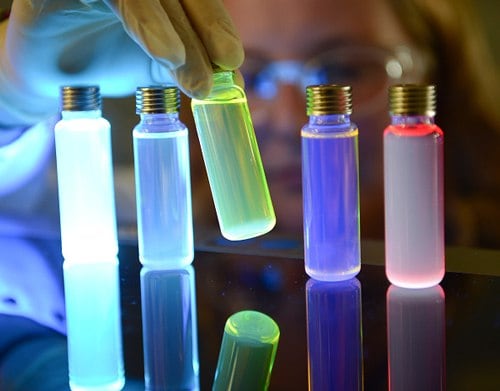OLED & PLED Materials

The organic light-emitting diode (OLED) is a high-performance optoelectronic device consisting of charge transport and emissive organic layers. Upon applied voltage, the dual carrier injection system of the OLED supplies both electrons and holes to the electroluminescent material between two electrodes, resulting in its characteristic electroluminescent light with specific color and device performance, depending on the organic materials employed in the device.
The two main classes of OLEDs include small-molecule based light emitting diodes and polymer-based light emitting diodes (PLEDs). A typical double-heterostructure small-molecule OLED consists of three organic layers sandwiched between electrodes. The organic layers adjacent to the cathode and anode are the electron transport layer (ETL) and the hole transport layer (HTL), respectively. The emissive layer (EML) usually consists of light-emitting dyes or dopants dispersed in a suitable host material (often HTL or ETL material). PLEDs have relatively simple architectures, with the light-emitting polymer (LEP) layer combining host, emitter and charge transport functions in a single solution-processed layer of the device.
We offer a series of high purity, state-of-art OLED materials, including sublimed small molecule light emitter and dopants, light emitting polymers, phosphorescent and fluorescent host materials, inorganic and sublimed organic electron transport (hole blocking) materials, hole injection & hole transport materials, thermally activated delayed fluorescent (TADF) dopants, and photosensitizing materials.
We also offer a selection of inorganic (Au, ITO, LiF) materials and substrates commonly used as substrates and electrodes in constructing OLED and PLED devices. Our innovative LEPs comprise the major chemical classes, including poly(phenylene vinylene) (PPV) and polyfluorene (PFO) polymers.
Products
Related Resources
- Article: Achieving High Efficiency in Organic Light-Emitting Devices
Electroluminescence of organic molecules has been a wellknown phenomenon for more than 50 years.
- Article: Plexcore® OC Hole Injection Inks
Plexcore® organic conductive inks are electronic grade inks formulated for use in the hole injection layers of OLEDs.
- Article: Light-Emitting Polymers
LEPs enable a wide range of important applications including sensors, flexible LED displays and lighting devices, optical pump lasers, and potentially polymer diode lasers.
- Article: Aggregation-induced Emission Luminogens for Non-doped Organic Light-emitting Diodes
Organic Light-emitting Diodes (OLEDs) are solid-state devices that transform electrical energy into light. OLEDs are considered the next generation technology for high-resolution flexible displays and solid state lighting, attracting intense scientific and industrial interest.
- Article: Inorganic Interface Layer Inks for Organic Electronic Applications
Find advantages of inorganic interface layer inks for organic electronic & other applications.
- Article: Organic and Hybrid Electronics in Optical Analytical Applications
Professor Shinar highlights low-cost, disposable sensor configurations in organic and hybrid electronics for healthcare applications.
- Article: Achieving High Efficiency in Organic Light-Emitting Devices
Electroluminescence of organic molecules has been a wellknown phenomenon for more than 50 years.
- Brochure: Innovative Materials for HighPerformance Optoelectronic Devices OPVs, OFETs, and OLEDs
In this issue, we discuss a variety of innovative materials, including both organic/polymeric molecules and inorganic nanomaterials, which have made superior optoelectronic devices become reality.
To continue reading please sign in or create an account.
Don't Have An Account?